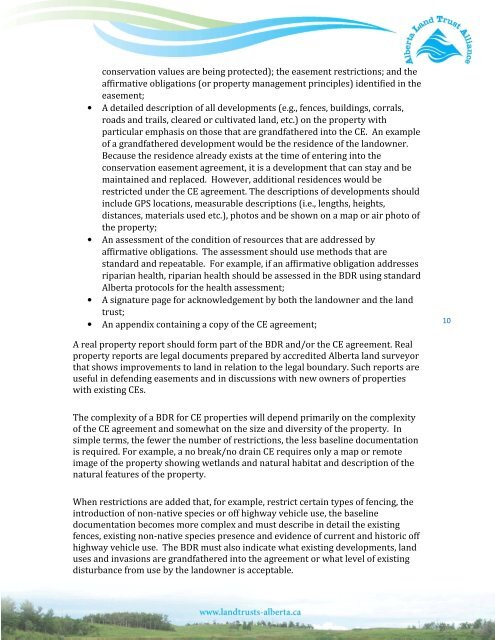MODULE #1 Baseline Documentation Report Training Module
MODULE #1 Baseline Documentation Report Training Module
MODULE #1 Baseline Documentation Report Training Module
You also want an ePaper? Increase the reach of your titles
YUMPU automatically turns print PDFs into web optimized ePapers that Google loves.
conservation values are being protected); the easement restrictions; and theaffirmative obligations (or property management principles) identified in theeasement;• A detailed description of all developments (e.g., fences, buildings, corrals,roads and trails, cleared or cultivated land, etc.) on the property withparticular emphasis on those that are grandfathered into the CE. An exampleof a grandfathered development would be the residence of the landowner.Because the residence already exists at the time of entering into theconservation easement agreement, it is a development that can stay and bemaintained and replaced. However, additional residences would berestricted under the CE agreement. The descriptions of developments shouldinclude GPS locations, measurable descriptions (i.e., lengths, heights,distances, materials used etc.), photos and be shown on a map or air photo ofthe property;• An assessment of the condition of resources that are addressed byaffirmative obligations. The assessment should use methods that arestandard and repeatable. For example, if an affirmative obligation addressesriparian health, riparian health should be assessed in the BDR using standardAlberta protocols for the health assessment;• A signature page for acknowledgement by both the landowner and the landtrust;• An appendix containing a copy of the CE agreement;10A real property report should form part of the BDR and/or the CE agreement. Realproperty reports are legal documents prepared by accredited Alberta land surveyorthat shows improvements to land in relation to the legal boundary. Such reports areuseful in defending easements and in discussions with new owners of propertieswith existing CEs.The complexity of a BDR for CE properties will depend primarily on the complexityof the CE agreement and somewhat on the size and diversity of the property. Insimple terms, the fewer the number of restrictions, the less baseline documentationis required. For example, a no break/no drain CE requires only a map or remoteimage of the property showing wetlands and natural habitat and description of thenatural features of the property.When restrictions are added that, for example, restrict certain types of fencing, theintroduction of non-native species or off highway vehicle use, the baselinedocumentation becomes more complex and must describe in detail the existingfences, existing non-native species presence and evidence of current and historic offhighway vehicle use. The BDR must also indicate what existing developments, landuses and invasions are grandfathered into the agreement or what level of existingdisturbance from use by the landowner is acceptable.




